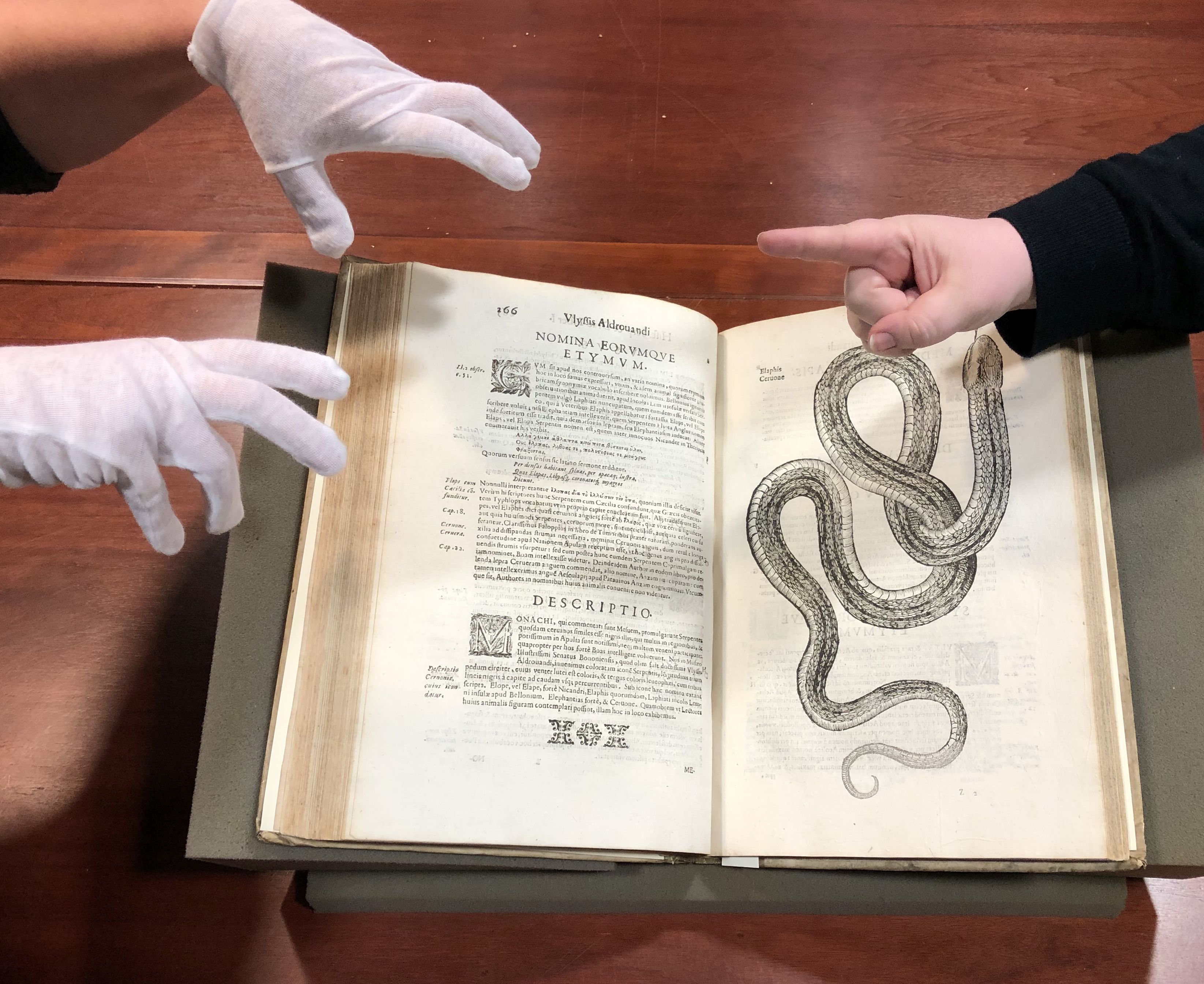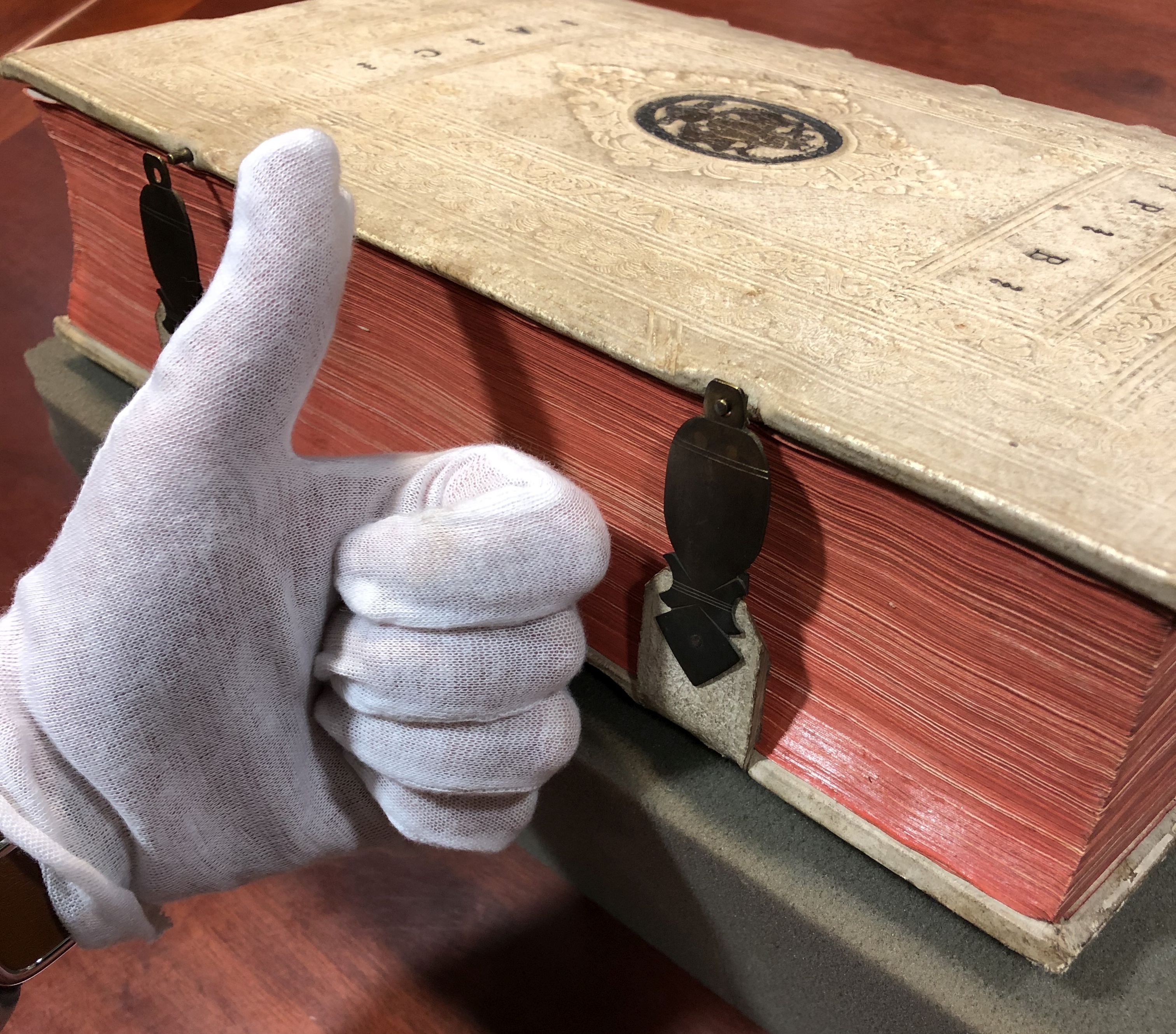There is a unique joy in watching a video or reading a news story with images of a librarian handling a rare book. Rare books, unlike many museum objects, are still used today in the same way that they would have been when they were new centuries ago – they’re held and opened, and their pages are turned. It would make sense that these historical objects should be handled with white gloves to keep them clean, right?

WRONG! Well, mostly. But we’ll get to that part later.
Smithsonian Libraries Special Collections stipulates that staff and readers have clean, dry hands when handling books. This is for several reasons:
- Hands in gloves lack the tactility and manual dexterity of bare hands. Handling a book with gloved hands could lead to accidentally torn pages when the gloves catch on fragile edges, or a dropped book if the gloves prove to be loose or slippery.
- Cotton gloves in particular have a tendency to lift fragments from pages, including pigments. Their fibers can catch in cracks that are invisible to the naked eye, further damaging friable pigments and inks.
- This also means that cotton gloves retain a lot of dirt, making them not so clean after all! In this same vein, gloves cause the hands to sweat, and this moisture can penetrate the gloves to wind up on the books. Ew!
In their brilliant article about the dangers of glove use in reading rooms, Cathleen A. Baker and Randy Silverman could find no scientific evidence that handling paper with bare hands causes chemical damage.[1] But even before modern scientific understanding of chemicals, gloves were not the librarian’s ally.
For the most part, advice on book handling through the centuries urges clean hands rather than the use of gloves. Ainsworth Rand Spofford describes how Nicolas Fouquet, noted book collector of the 17th century, insisted that his books only be handled with white gloves,[2] but this appears to be an isolated instance. Baker and Silverman trace white glove use for preservation back to only the late 19th century, when it was intended largely for photographs.[3] The British Library’s Medieval Manuscript Blog post on the topic cites a medieval source that describes how reading a book with gloved hands was frowned upon in that period, too; admittedly, this medieval source was more concerned with decrying the “extravagance” of reading while gloved, warning that it was a path to purgatory.[4] But the point stands!
So how did white gloves make their way into the popular conception of special collections libraries? Baker and Silverman speculate that the idea of white-gloved librarians is only about 20 years old, and stems from canny vendors and archival supply catalogs praising their virtues.[5] However, a point can also be made about the representation of libraries, librarians, and rare books in the media. White glove use acts as a visual shorthand for “old and valuable object,” allowing a writer or commentator to save that narrative space for other story elements. The ubiquity of the association of white gloves with rare books also indicates that many people’s first knowledge of special collections comes from popular media, rather than specialists. This information can be used to better connect with potential users, but also indicates that perhaps writers and video-makers ought to do a bit more research before they put their librarian in gloves.
But, like most things having to do with rare books, exceptions to the glove prohibition abound. The largest is photographic material: a large body of scientific evidence indicates that any amount of oil or residue on skin can react with the sensitive chemicals used in the photographic process. Another is books with lots of metal components (clasps, bosses, and protective corner-pieces), for similar reasons. A further important exception is made for otherwise “normal” rare books that contain toxic elements such as arsenic. While it is important that we strive not to damage books, it is far more important that the books do not damage you!

So next time you see a character in a TV show donning white gloves to page through a rare book, feel free to tut at your screen. The librarians of Smithsonian Libraries Special Collections will be right there with you.
With thanks to hand models Liz O’Brien and Kirsten van der Veen!
[1] “Misconceptions about White Gloves,” International Preservation News No. 37, December 2005. https://www.ifla.org/files/assets/pac/ipn/ipnn37.pdf
[2] A Book for All Readers (New York: G. P. Putnam’s Sons), 1905, 117.
[3] Baker and Silverman, 7.
[4] “White Gloves or Not White Gloves,” Medieval Manuscripts Blog, 19 August 2011. https://blogs.bl.uk/digitisedmanuscripts/2011/08/white-gloves-or-not-white-gloves.html
[5] Baker and Silverman, 7.

17 Comments
That’s a great article. People are always asking me why we don’t use gloves….our explanation is the same, but you’ve made it much more interesting.
What about kid gloves?
For use with vellum or parchment only?
Kid gloves really get our goat too! 😉
Three cheers for common sense in a world cluttered with caution.
While the point of the article is cotton glove use, I would like to have seen a brief discussion of the use of later/surgical gloves which provide greater dexterity and still provide a barrier. I both kinds of gloves when handling negatives and fine art prints.
It is true that surgical/nitrile gloves to provide *greater* dexterity, but they still do not enable *full* dexterity. They are also somewhat tacky (in the “sticky” sense), and so still present a threat to friable pigments and brittle papers. However, we do use nitrile gloves for handling photographic material and negatives.
What about nitrile gloves? We have a large stock of photographic (not chemical analysis) evidence, that residues on fingers damage the paper. Nitrile gloves are much less permeable and the signal-value of handling an object with gloves should not be neglected.
While nitrile gloves provide more maneuverability than cotton gloves, they still cannot replace the tactile feedback of handling an object with bare hands. They are also somewhat tacky (in the “sticky” sense), and so still present a threat to friable pigments and brittle papers. In consultation with our conservators, we determined that enforcing hand washing with soap and water before handling rare materials sufficiently reduces hand residue.
Displaying that we handle our materials with care is indeed important, but it does not function as collections care, particularly if researchers are under the impression that they are being more cautious when they are in fact doing the opposite. We prefer to review and demonstrate proper handling techniques with researchers and visitors.
Here Here! this is perfect ..
James
I appreciated this blog post so much I wrote a short story based on it! It’s, uh… Star Wars, and the Voynich Manuscript makes an appearance.
“Gloveless”: https://archiveofourown.org/works/21524035
What about documents made from animal parchments? What kind of issues do gloves/bare hands/surgical gloves pose for those items? I’m certain that their being made of animal product changes how they wear somehow, but I’m not sure.
Good article Allie and important for special collections everywhere. I have worked in public libraries where the special collections white gloves sometimes look something other than white. Thanks for the reference to “Misperceptions About White Gloves”. I like your reply in the comments section about kid gloves getting your goat, nice!
Make sure you wear a mask, though. :>O
[…] favorite fantasy fiction, movies, and even Mr. Bean aside, wearing cotton gloves (aka the “cotton menace”) isn’t the best way to show love for rare books when you handle them. As the Ransom […]
[…] rare book librarians, preservation specialists, and conservators already know: there’s “no love for white gloves.” While many folks have written thoughtful articles and posts about why (and some of those […]
[…] “No Love for White Gloves, or: the Cotton Menace,” Smithsonian Libraries Blog, 21 november 2019. https://blog.library.si.edu/blog/2019/11/21/no-love-for-white-gloves-or-the-cotton-menace […]